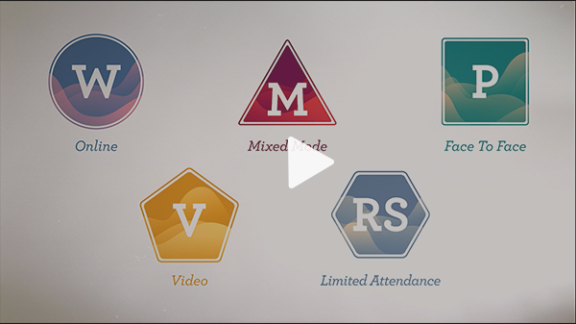Bringing TOPkit Digest to You
|
|
Contents of this Digest:
- Video Tip: Understanding Course Modalities and Attributes
- Announcement: Register for the Summer 2021 TOPkit Online CoLAB speed networking event!
- Top Tips: Online Professional Development Beyond the Pandemic
- From the Community: Professionals Developing, Delivering, and Sharing Resources
- Ask ADDIE: Faculty Development and Modalities
- Top Community Topics
|
|
Understanding Course Modalities and Attributes
Student Course Selection & Faculty Design and Development |
|
|

|
|
This University of Central Florida video provides information intended for student understanding of course modalities to assist in making informed decision on course selection. This video can also be used for faculty development to ensure faculty understand the available modalities. Understanding modality and student expectations will assist them in the design and development stages to create appropriate activities and assessment in their courses.
|
|
MUST-READ ANNOUNCEMENT
Join us for the Summer 2021 TOPkit Online CoLAB speed networking event that connects instructional designers and technology professionals for a fun blast of conversational exchanges. Learn more and register for this June 3rd event!
|
|
Online Professional Development Beyond the Pandemic
When Possible, Use What You Have or Can Find! |
|
|
|
Many institutions have been delivering professional development to their faculty transitioning from face-to-face to online teaching/learning for some time. The recent pandemic has not only increased the number of courses being delivered in the online mode but it has also sparked some new online modalities (i.e., hybrid, online, live synchronous, remote or virtual, hyflex, blendflex) for many institutions. This move warrants a need for additional professional development offerings and resources to prepare faculty for success. With a quick turnaround time and a need for positive student outcomes, it’s important to create an effective course catered to each modality’s delivery requirements. Promote that faculty stick to the basics. No need for bells and whistles when the delivery date is impending. What are the course objectives? What online activities/content can assist in delivering/teaching students those objectives? How can you assess that the objectives have been taught? Below are a few ideas and solutions to reach your desired outcome.
|
|
|
|
|
|
|
|
|
#1 - Use what you got! Most institutions have been delivering faculty development to prepare faculty for success with online teaching and learning in one way or another. Start with what you have and take a good look at it. If it can be modified to cover the necessary modalities, make those changes and deliver it to the appropriate learner.
|
|
#2 - Find something useful. If your institution does not have a professional development program to prepare faculty for teaching in different modalities, complete a search to see if there’s something out there that can be used. Like the TOPkit Sample Courses! Also, TOPkit will be adding UCF’s Essentials of Online Teaching course which is what was used for emergency training at their institution for online and hybrid courses.
|
|
#3 - Define modalities and be on the same page. It is important for the institution to define the modalities they will offer and to explain them in a way that is clear to the faculty developing and delivering these courses as well as the students taking them. | |
#4 - Page templates are your friend. If you are at an institution that uses a learning management system (LMS), create some basic templates for faculty to utilize. Syllabus, Schedule, Welcome Page, and Module Overviews are a great start. Customize each template to cater to the essentials of the different modalities you offer. UT Canvas (The University of Texas at Austin) provides templated course imports for their different modalities.
#5 - Design active learning activities and assessments that will utilize the tools and time you have with students (in class or online). If you have a hybrid course, decide what you can do while you have them in class and what can be done online. If going completely online, what activities can be implemented and what adaptions need to occur.
#6 - Use authoritative sources. It is best to link faculty resources and student resources to the authoritative source. For example, if you’re using Zoom, don’t create your own “How Tos” but instead link them to the tutorials created by the software/platform. Many of these products have received a considerable amount of new business and are already soliciting feedback and making changes to interface and capabilities.
Odds are most instructors will not go back to their traditional face-to-face method of teaching even when the face-to-face delivery is deemed safe. Faculty seem to embrace and adopt technology when it (1) makes their job easier and (2) benefits student outcomes. This excitedly means that faculty will most likely use the online modality in one way or another. This may be minimal as in posting the syllabus and grades, to more prevalent usage such as promoting student-to-student collaboration. No matter the reason, institutions need to plan for more resources devoted to the online teaching. That could be adopting an LMS, increasing tech support, and, when possible, hiring more instructional designers to assist with online professional development and course delivery.
|
|
|
Sue A. Bauer, M.S., Senior Instructional Designer and Project Manager, Center for Distributed Learning, University of Central Florida (SueB@ucf.edu)
|
|
Professionals Developing, Delivering, and Sharing Resources
|
|
|
|
Many higher education institutions went online during the Spring 2020 term and have continued online. Institutions went from reactive efforts to sustainable efforts. Take time to review some of the resources that came from these two methods of professional development.
|
|
- Anderton Ryan S., Vitali Julian, Blackmore Conner, Bakeberg Megan C. (2021). Flexible Teaching and Learning Modalities in Undergraduate Science Amid the COVID-19 Pandemic. Frontiers in Education, 5, S278. https://www.frontiersin.org/article/10.3389/feduc.2020.609703
- Davidson, C. (2020). Interactive and Experiential Modalities for Online Teaching and Converting our Courses in the Time of the Pandemic. Association for Experiential Education. https://aee.memberclicks.net/interactive-and-experiential-modalities-for-online-teaching-and-converting-our-courses-in-the-time-of-the-pandemic
- Mukhtar, K., Javed, K., Arooj, M., & Sethi, A. (2020). Advantages, Limitations and Recommendations for online learning during COVID-19 pandemic era. Pakistan Journal of Medical Sciences, 36(COVID19-S4), S27–S31. https://doi.org/10.12669/pjms.36.COVID19-S4.2785
|
|
|
Sue A. Bauer, M.S., Senior Instructional Designer and Project Manager, Center for Distributed Learning, University of Central Florida (SueB@ucf.edu)
|
|
Faculty Development and Modalities
Hyflex, Blendflex, Asynchronous, Synchronous: Decoding Modalities |
|
|
|
 | |
Dear ADDIE, The shift to remote teaching during the ongoing pandemic has prompted faculty to deliver creative online experiences for their students, combining different modes of delivery and using new technology tools. My university needs a way of categorizing these different mode options so that faculty will know the parameters of how to deliver their courses, students can make informed course enrollment decisions, and internal staff can have a common language to support faculty and student’s efforts for success. Could you use your decoder expertise and help us decipher between the different modalities? Signed, Caesar Cipher
|
|
References:
- Active Learning in Remote, Virtual Hybrid, Online, and Physically Distanced Classrooms. (2020). Retrieved from https://trefnycenter.mines.edu/active-learning-in-remote-virtual-hybrid-online-and-physically-distanced-classrooms/
- Anderton Ryan S., Vitali Julian, Blackmore Conner, Bakeberg Megan C. (2021). Flexible Teaching and Learning Modalities in Undergraduate Science Amid the COVID-19 Pandemic. Frontiers in Education, 5, S278. Retrieved from
https://www.frontiersin.org/article/10.3389/feduc.2020.609703 - Bauer, S., Raible, J., Tojo, J., Salter, A., Wyatt, S., & Howard, W. (2015). TOPkit Sample Courses. Retrieved from https://topkit.org/developing/sample-course/
- Davidson, C. (2020). Interactive and Experiential Modalities for Online Teaching and Converting our Courses in the Time of the Pandemic. Association for Experiential Education. Retrieved from https://aee.memberclicks.net/interactive-and-experiential-modalities-for-online-teaching-and-converting-our-courses-in-the-time-of-the-pandemic
- Course Modalities and Attributes at UCF. (2021). Retrieved from https://cdl.ucf.edu/support/student/modalities/
- Essentials of Online Teaching (EOT) Summer 2020 Course Schedule. (2020). Retrieved from https://cdl.ucf.edu/wp-content/uploads/2020/06/EOT_Summer2020_Schedule.pdf
- Mukhtar, K., Javed, K., Arooj, M., & Sethi, A. (2020). Advantages, Limitations and Recommendations for online learning during COVID-19 pandemic era. Pakistan journal of medical sciences, 36(COVID19-S4), S27–S31. Retrieved from https://doi.org/10.12669/pjms.36.COVID19-S4.2785
- The University of Texas at Austin Canvas Templates. (2021). Retrieved from https://utexas.instructure.com/courses/633028/pages
/canvas-templates - Tips & Tricks: Teachers Educating on Zoom. (2020). Retrieved from https://zoom.us/docs/doc/Tips%20and%20Tricks%20for%20Teachers
%20Educating%20on%20Zoom.pdf
|
|
Content Coordinator and Contributor
Sue A. Bauer, M.S., Senior Instructional Designer and Project Manager, Center for Distributed Learning, University of Central Florida (SueB@ucf.edu) Developer and Editor
Bren Bedford, MNM, Web Project Analyst, Center for Distributed Learning, University of Central Florida
Editor
Samantha Richardson, B.A. English, Communications Specialist, Pegasus Innovation Lab, Center for Distributed Learning, University of Central Florida
|
|
|


